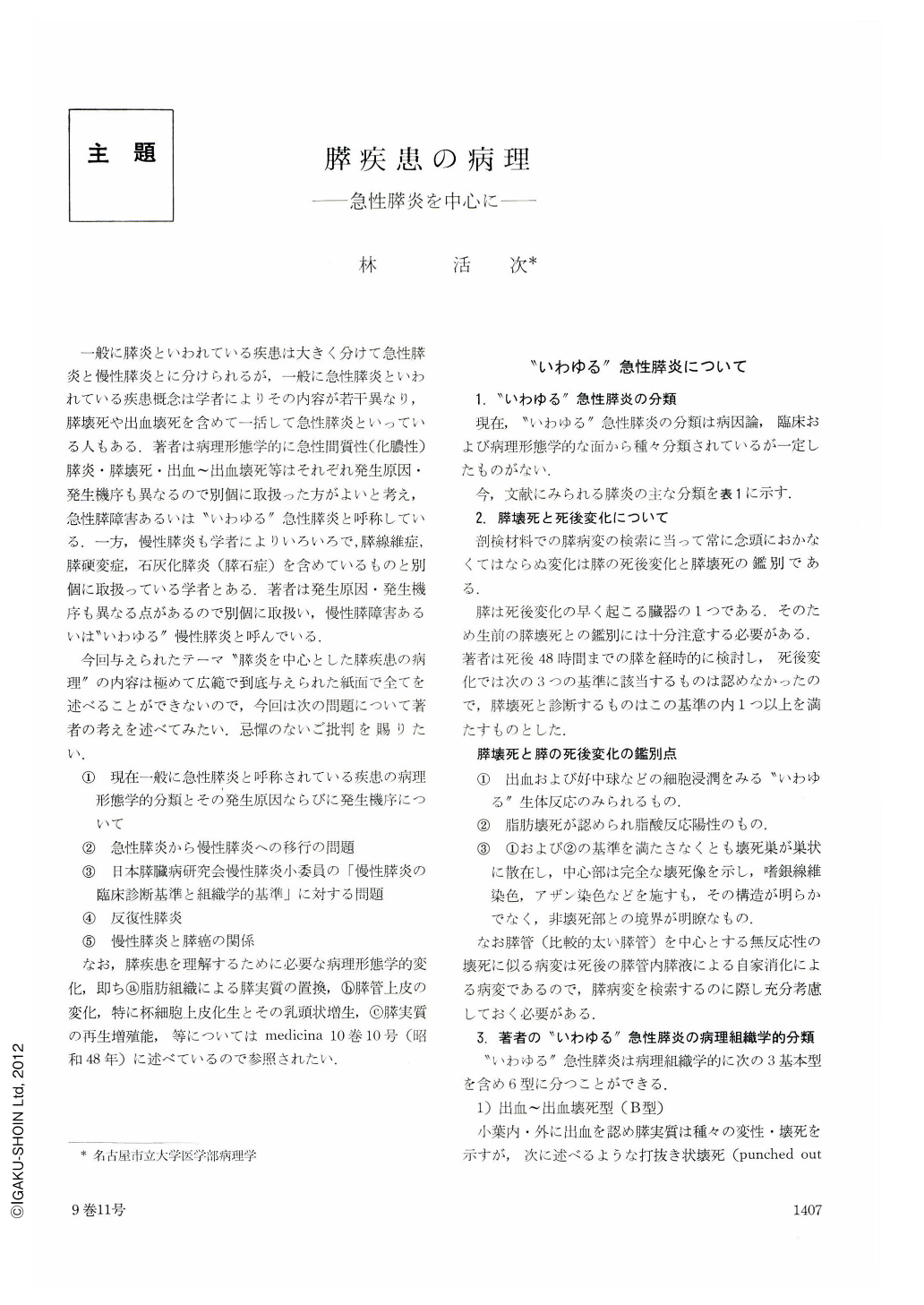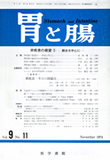Japanese
English
- 有料閲覧
- Abstract 文献概要
- 1ページ目 Look Inside
一般に膵炎といわれている疾患は大きく分けて急性膵炎と慢性膵炎とに分けられるが,一般に急性膵炎といわれている疾患概念は学者によりその内容が若干異なり,膵壊死や出血壊死を含めて一括して急性膵炎といっている人もある.著者は病理形態学的に急性間質性(化膿性)膵炎・膵壊死・出血~出血壊死等はそれぞれ発生原因・発生機序も異なるので別個に取扱った方がよいと考え,急性膵障害あるいは“いわゆる”急性膵炎と呼称している.一方,慢性膵炎も学者によりいろいろで,膵線維症,膵硬変症,石灰化膵炎(膵石症)を含めているものと別個に取扱っている学者とある.著者は発生原因・発生機序も異なる点があるので別個に取扱い,慢性膵障害あるいは“いわゆる”慢性膵炎と呼んでいる.
今回与えられたテーマ“膵炎を中心とした膵疾患の病理”の内容は極めて広範で到底与えられた紙面で全てを述べることができないので,今回は次の問題について著者の考えを述べてみたい.忌憚のないご批判を賜りたい.
A histopathological study has been made of the so-called acute pancreatitis with the following results:
1. The so-called acute pancreatitis can be divided into three fundamental types: (1) hemorrhagic and/or hemorrhagico-erosive type; (2) punched-out necrosis type and (3) inflammatory type = phlegmon of the pancreas.
2. Hemorrhagic and/or hemorrhagico-erosive type manifests itself as bleeding into the periacinar space in the lobulus, followed by degeneration and necrosis of acinar cells and then by secondary massiv hemorrhage due to interlobular vascular disorders caused by liberated pancreatic enzymes. Substantially it is bleeding and not inflammation. The greater majority of this type is fatal in its outcome.
3. Punched-out necrosis takes place through accumulation of the pancreatic juice due to narrowing or obstruction of the pancreatic ducts, through reflux phenomenon of the pancreatic juice leaking around acinar cells caused by sustained secretion of the exocrine glands and through autolysis due to activation of oozed-out pancreatic juice. Cancer of the papillary region or of the head of the pancreas and calculus can account for the narrowing or obstruction of the pancreatic ducts, but papillary proliferation of the ductal epithelium accompanied by goblet cell metaplasia must also be taken in due consideration. The true nature of this type is not inflammation but regressive changes. The course of healing never takes the form of scarring. Necrosis usually absorbed and replaced by fatty tissue. At times, however, pseudocyst may be formed.
4. Inflammatory type=phlegmon of the pancreas does really represent inflammation. When the outflow of the pancreatic juice is disturbed, inflammation occurs through infection (mostly Escherichia coli) either ductally from the duodenum or via lymphatic vessels. The obstructed outflow of the juice can well be caused by cancer or calculi, but we attach as great importance to papillary proliferation of the ductal epithelium in association with goblet cell metaplasia. This is the type in which the so-called acute pancreatitis changes into chronic one. It seems hardly possible that other types are responsible for the transition from acute to chronic pancreatitis.

Copyright © 1974, Igaku-Shoin Ltd. All rights reserved.


